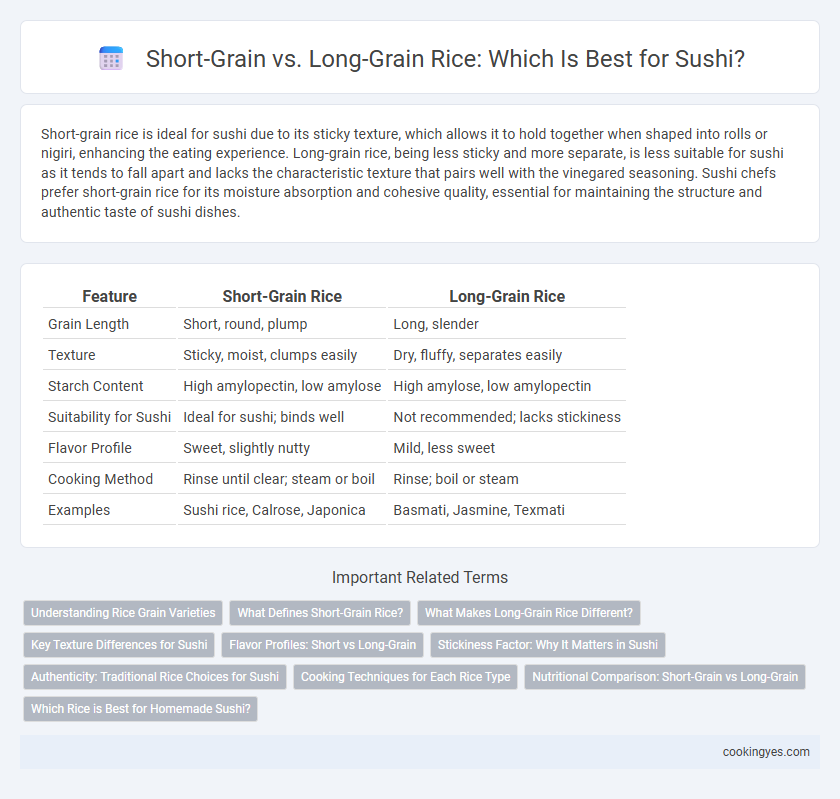Short-grain rice is ideal for sushi due to its sticky texture, which allows it to hold together when shaped into rolls or nigiri, enhancing the eating experience. Long-grain rice, being less sticky and more separate, is less suitable for sushi as it tends to fall apart and lacks the characteristic texture that pairs well with the vinegared seasoning. Sushi chefs prefer short-grain rice for its moisture absorption and cohesive quality, essential for maintaining the structure and authentic taste of sushi dishes.
Table of Comparison
| Feature | Short-Grain Rice | Long-Grain Rice |
|---|---|---|
| Grain Length | Short, round, plump | Long, slender |
| Texture | Sticky, moist, clumps easily | Dry, fluffy, separates easily |
| Starch Content | High amylopectin, low amylose | High amylose, low amylopectin |
| Suitability for Sushi | Ideal for sushi; binds well | Not recommended; lacks stickiness |
| Flavor Profile | Sweet, slightly nutty | Mild, less sweet |
| Cooking Method | Rinse until clear; steam or boil | Rinse; boil or steam |
| Examples | Sushi rice, Calrose, Japonica | Basmati, Jasmine, Texmati |
Understanding Rice Grain Varieties
Short-grain rice grains are plump, sticky, and high in amylopectin, making them ideal for sushi by providing the necessary cohesion to hold the ingredients together. In contrast, long-grain rice has a lower starch content and remains fluffy and separate when cooked, which is less suitable for sushi preparation. Understanding these differences in grain size, texture, and starch composition is crucial for selecting the perfect rice variety to achieve authentic sushi texture and flavor.
What Defines Short-Grain Rice?
Short-grain rice is defined by its plump, almost round kernels and high amylopectin content, which gives it a sticky texture essential for sushi making. Its moisture retention and softness allow the grains to clump together, providing the characteristic chewiness required for sushi rolls and nigiri. This stickiness contrasts sharply with the separate, fluffy grains of long-grain rice, making short-grain rice the preferred choice for authentic sushi preparation.
What Makes Long-Grain Rice Different?
Long-grain rice differs from short-grain rice primarily in its lower starch content, which results in a drier and more separate texture when cooked. This characteristic makes long-grain rice less sticky and less suitable for sushi, where the adhesive quality of rice is essential for shaping and holding together. The elongated shape of long-grain rice grains also prevents the compact, cohesive texture required for traditional sushi preparation.
Key Texture Differences for Sushi
Short-grain rice for sushi is sticky and clumps together, making it easier to shape and hold with chopsticks. Long-grain rice has a firmer, drier texture and tends to be less sticky, resulting in less cohesion in sushi rolls. The high starch content in short-grain rice enhances its softness and elasticity, essential for traditional sushi preparation.
Flavor Profiles: Short vs Long-Grain
Short-grain rice has a sticky texture and a slightly sweet, rich flavor that enhances the traditional sushi experience by holding the ingredients together effectively. Long-grain rice offers a firmer texture with a subtle nutty taste but tends to be less sticky, making it less ideal for authentic sushi preparation. The choice between short-grain and long-grain rice significantly impacts the overall flavor and texture, with short-grain preferred for its balance of moisture and stickiness essential for sushi.
Stickiness Factor: Why It Matters in Sushi
Short-grain rice is preferred for sushi due to its high starch content, which creates the essential stickiness needed to hold sushi rolls together. Long-grain rice, with less amylopectin, remains fluffy and separate, making it unsuitable for forming compact sushi pieces. The stickiness factor directly impacts the sushi's texture and structural integrity during preparation and consumption.
Authenticity: Traditional Rice Choices for Sushi
Authentic sushi traditionally uses short-grain rice, prized for its sticky texture that helps the rice adhere to other ingredients. This variety has a higher starch content, creating the ideal balance of moisture and chewiness essential in sushi preparation. Long-grain rice lacks this sticky quality, making it less suitable for maintaining the structural integrity of sushi rolls.
Cooking Techniques for Each Rice Type
Short-grain rice, prized for its sticky texture, requires rinsing thoroughly to remove excess starch before cooking with slightly less water and a shorter steaming time to achieve its characteristic chewiness. Long-grain rice, less sticky and fluffier, benefits from soaking for 20-30 minutes and using a higher water ratio to ensure separate, firm grains ideal for dishes needing distinct rice pieces. Mastering water proportions and cooking duration tailored to each rice type enhances sushi quality by preserving texture and flavor.
Nutritional Comparison: Short-Grain vs Long-Grain
Short-grain rice typically contains higher starch content, resulting in a stickier texture ideal for sushi, while long-grain rice has lower starch and a fluffier texture. Nutritionally, short-grain and long-grain rice provide similar calories and macronutrients, but short-grain rice often has slightly more carbohydrates and less fiber. Both types offer essential vitamins like B-complex and minerals such as magnesium and phosphorus, supporting energy metabolism and bone health.
Which Rice is Best for Homemade Sushi?
Short-grain rice is best for homemade sushi due to its sticky texture, which allows it to hold together and maintain the shape of sushi rolls and nigiri. Long-grain rice tends to be drier and less sticky, making it unsuitable for traditional sushi preparation. Using authentic Japanese short-grain rice enhances the flavor and texture, ensuring an authentic sushi experience at home.
Short-grain vs Long-grain for sushi Infographic

 cookingyes.com
cookingyes.com